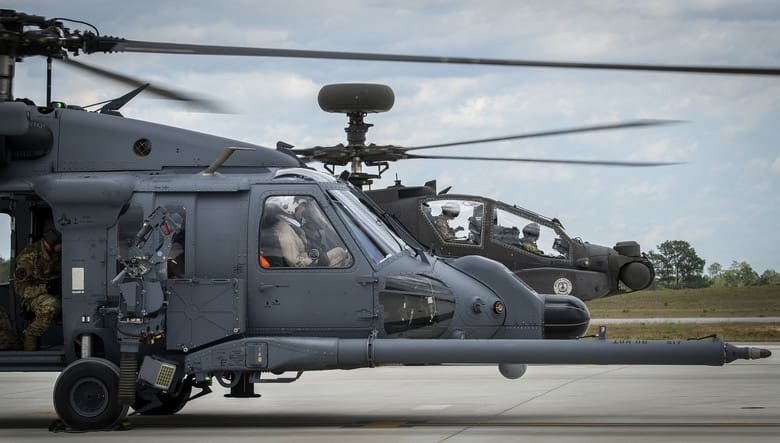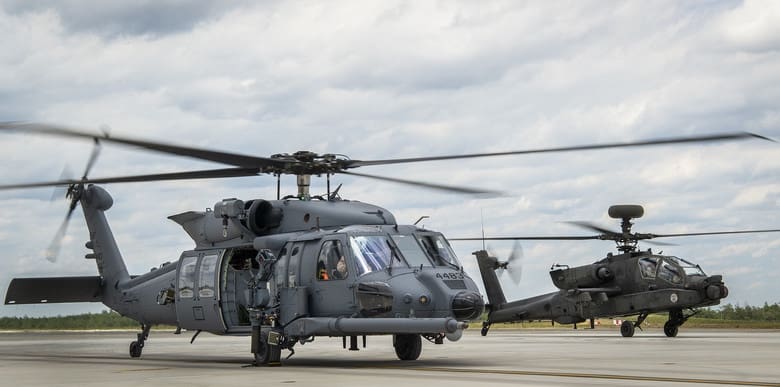
EGLIN AIR FORCE BASE, Fla. (AFNS) —
Those common, vibrating “thwip” helicopter sounds arrived well before they showed up, as 413th Flight Test Squadron personnel turned to look to the north at Eglin Air Force Base, May 19.
Seconds later, two helicopters appeared and the sounds and vibrations intensified. The Air Force’s newest combat search and rescue helicopter, the HH-60W Jolly Green II, led the way down the Duke Field runway. It was followed by the Army’s multi-role combat helicopter, the AH-64 Apache.
The two aircraft landed at Eglin AFB completing their first flight and combined test mission together.

The Apache, from Redstone Army Test Center, Alabama, flew in for system testing with the HH-60W.
“The unique configuration of the AH-64 Apache gave our team the opportunity to test capabilities of the HH-60W in ways normally not possible here,” said Christopher Martin, 413th FLTS HH-60W lead test engineer “Tests like these will ensure the Jolly Green II will be able to perform its critical combat search and rescue mission when fielded in the joint warfighting environment.”
The joint service test-effort marks another milestone in Jolly Green II’s development. This year, the new helicopter has completed extreme environment, communications and defense system testing just to name a few.
The 413th FLTS leads the HH-60W integrated test team along with members of Sikorsky Aircraft Corporation, 88th Test and Evaluation Squadron, Detachment 2, and Air Force Operational Test Center.
“We are very proud of the work our integrated test team accomplished in 2020 despite a myriad of operational restrictions due to COVID-19,” said Shawn Hammond, HH-60W test program manager. “The team’s success is due to a mission-focused mindset to ensure the crews flying the Jolly Green II into combat have the most reliable and capable helicopter for the job.”
By Samuel King Jr., Eglin Air Force Base Public Affairs


It would be nice if Pedro actually did anything other than trying to snipe Army Medevac missions.
Like going to a POI without escort?
I’ve never seen a Pave Hawk do that, though I’ve gone to plenty of POI’s with just another Medevac 60 as chase.
When I was in Erbil in 2014-15 it was the Army Medevac that flew all the missions, though the AF got all the press.
And I do find it very funny that you are comparing performance in an exercise versus performance in a real world environment.
I’m not blaming the crews of the CSAR birds, they do their best, but they are put in a bad spot by the Air Force.
Pedro deployed and flew because the Army said it needed augmentation on the MedEvac mission.
The Navy augmented the Army in Iraq (07 to 08) when I was there.
More constructively, the downed aviator recovery mission sounds good on paper, but the amount of time and effort expended on it compared to the the number of times it’s actually used makes it not worth the effort.
A QRF composed of either Army assault and Medevac/Casevac assets, or the same from Marine and Naval aviation can do the same mission while offering greater flexibility to the force.
But they’re not dedicated. Go read up on Joint Pub 3-50.
“The Air Force
1-27. Air Force considers combat search and rescue a primary task. The Air Force equips and trains dedicated forces for personnel recovery, organized under the numbered air forces. ”
JP 3-50
Look at what an Army QRF tried to do in Desert Storm or the crap show that was the HSC-85 rescue of the MC-12 outside of Erbil. Go to a RED FLAG and see how well as-hoc PR forces will do against an IADS or a real treat county. None of the other services have dedicated PR forces that aren’t chopped to some other mission.
Ok, that was FM 3-50.1, but still.